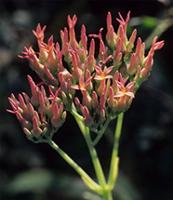(Haw.) Haw., Crassulaceae

|

|

|

|

|
|
(Haw.) Haw., Crassulaceae |
|
Present on Pacific Islands? yes
Primarily a threat at high elevations? no
Risk assessment results: High risk; score: 10 (Hawaii-Pacific Weed Risk Assessment for Kalanchoe rotundifolia)
Other Latin names: Crassula rotundifolia Haw.; Kalanchoe integerrima Lange
Common name(s): [more details]
|
English: common kalanchoe |
|
Unknown: nentabos, plakkie, umadinsane |
Habit: succulent
Description: "[G]labrous; stem slender, laxly leafy below, naked upwards; leaves roundish-obovate, obovate or spathulate, subentire or crenulate, tapering at base, subpetiolate; cymes trichotomous, panicled, the subdivisions flat-topped; bracts and sepals small, subulate; lobes of the corolla narrow-lanceolate, acute. Stems 1–3 feet high, leafy below; the upper internodes 5–8 inches apart, with smaller and narrower leaves. Lower leaves 1–2 inches long, 3/4–1 inch wide, often quite entire, fleshy. Cymes flat-topped, simple or trichotomously panicled, the lateral divisons on long common peduncles. Pedicels 3–4 lines long. Calyx 1 line. Corolla 4–5 lines long, orange or deep yellow." (JSTOR Global Plants)
Habitat/ecology: "It [Kalanchoe rotundifolia] is a very common plant found growing as a pioneer plant on poor soils in full sun and partial shade on road cuttings, road verges, on rooftops and derelict land.... They reproduce naturally by means of vast amounts of very small seed which germinates readily under ideal conditions. ...plants are very drought resistant often growing where there is virtually no soil." (Gardening in Africa)
In cultivation (within native range): "In summer rainfall regions there is no need to water as rain will be sufficient." (Plantz Africa [Thompson T. Mutshinyalo, Walter Sisulu National Botanical Garden, May 2001])
Propagation: "This is an easy plant to propagate from both seed and cuttings. ... Kalanchoe rotundifolia will successfully seed itself in the garden and once it is established it will persist for many years." (Plantz Africa [Thompson T. Mutshinyalo, Walter Sisulu National Botanical Garden, May 2001])
[Kalanchoe rotundifolia] "reproduce[s] naturally by means of vast amounts of very small seed which germinates readily under ideal conditions." (Gardening in Africa)
Native range: Kalanchoe rotundifolia (Haw.) Haw. (Crassulaceae) is native to Africa (Tanzania, Yemen, Mozambique, Zimbabwe, Botswana, Lesotho, Namibia, South Africa, and Swaziland). (GRIN)
Impacts and invaded habitats: The Global Compendium of Weeds website cites this species as a weed--and specfically as an agricultural weed--in southern Africa. (GCW; see also GCW terminology)
If you know of other invaded habitats or impacts, please let us know.
Presence:
| Pacific | |||
|
Country/Terr./St. & Island group |
Location |
Cited status &
Cited as invasive & Cited as cultivated & Cited as aboriginal introduction? |
Reference &
Comments |
|
State of Hawaii
Hawaiian Islands |
Maui Island | Consortium of Pacific Herbaria (2018) | |
|
State of Hawaii
Hawaiian Islands |
Maui Island |
introduced
|
Starr, Forest/Starr, Kim (2014)
Starr voucher #140624 01, collected 24-Jun-2014, 2125', Kula, Maui (Hawaii) "Dozens of plants along the road here, all size classes present. Naturalized." |
| Pacific Rim | |||
|
Country/Terr./St. & Island group |
Location |
Cited status &
Cited as invasive & Cited as cultivated & Cited as aboriginal introduction? |
Reference &
Comments |
|
Asia
Asia |
Socotra |
native
|
University of Connecticut (year unknown)
accessed 20190212, presumably native based on context of ref (pt@philipt.com/20190212) |
|
United States (west coast)
United States (west coast states) |
USA (California) |
cultivated
|
Dave's Garden (year unknown)
accessed 20190214 |
| Also reported from | |||
|
Country/Terr./St. & Island group |
Location |
Cited status &
Cited as invasive & Cited as cultivated & Cited as aboriginal introduction? |
Reference &
Comments |
|
Africa
Africa |
Africa |
native
|
U.S. National Plant Germplasm System (year unknown)
accessed 20190212, see ref for countries/detail ("NORTHEAST TROPICAL AFRICA: Yemen [Socotra]; EAST TROPICAL AFRICA: Tanzania; SOUTH TROPICAL AFRICA: Mozambique, Zimbabwe; SOUTHERN AFRICA: Botswana, Lesotho, Namibia, South Africa, [Cape Province (e.), Free State (w.), KwaZulu-Natal, Transvaal] Swaziland (e.)" as of 20190212) |
|
Africa
Africa |
Zimbabwe |
native
cultivated |
Plantz Africa (year unknown)
accessed 20190212, "Kalanchoe rotundifolia is widely distributed in South Africa and Zimbabwe." "This is an easy plant to propagate from both seed and cuttings. ... Kalanchoe rotundifolia will successfully seed itself in the garden and once it is established it will persist for many years." |
|
Europe
Europe |
Belgium |
greenhouse
cultivated |
Billiet, F. (2004)
accessed 20190212 |
|
South Africa
South Africa |
South Africa (Republic of) |
native
|
JSTOR Global Plants (year unknown)
(presumed native based on typical format of this reference; pt@philipt.com/20190212) |
|
South Africa
South Africa |
South Africa (Republic of) |
native
cultivated |
Plantz Africa (year unknown)
accessed 20190212, "Kalanchoe rotundifolia is widely distributed in South Africa and Zimbabwe." "This is an easy plant to propagate from both seed and cuttings. ... Kalanchoe rotundifolia will successfully seed itself in the garden and once it is established it will persist for many years." |
|
South Africa
South Africa |
South Africa (Republic of) |
native
|
University of Connecticut (year unknown)
accessed 20190212 |
|
United States (continental except west coast)
United States (other states) |
United States (other states) |
greenhouse
cultivated |
University of Connecticut (year unknown)
in cultivation (greenhouse) in Connecticut (e.g.), accessed 20190212 |
Comments: Kalanchoe rotundifolia is available for purchase online and is documented to be cultivated in various places; it's likely that it's cultivated in (many?) more places than are documented in the PIER database/website (PIER ed./14 February 2019).
Control: If you know of control methods for Kalanchoe rotundifolia, please let us know.